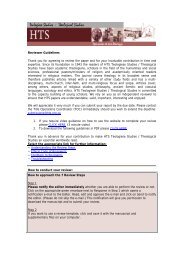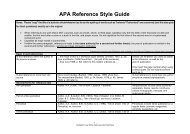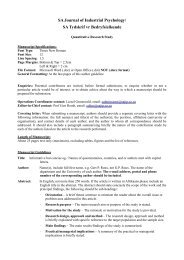SA Journal of Industrial Psychology/
SA Journal of Industrial Psychology/
SA Journal of Industrial Psychology/
Create successful ePaper yourself
Turn your PDF publications into a flip-book with our unique Google optimized e-Paper software.
<strong>SA</strong> <strong>Journal</strong> <strong>of</strong> <strong>Industrial</strong> <strong>Psychology</strong>/<br />
<strong>SA</strong> Tydskrif vr Bedryfsielkunde<br />
Theoretical Research Study<br />
Manuscript Specifications:<br />
Font Type: Times New Roman<br />
Font Size: 12<br />
Line Spacing: 1.5<br />
Page Margins: Bottom & Top = 2.5cm<br />
Left & Right = 2 cm<br />
File Format: Micros<strong>of</strong>t Word (.doc) or Open Office (.dot) NOT (.docx format)<br />
General Formatting: At the last pages <strong>of</strong> this author guideline<br />
Enquiries: Potential contributors are invited, before formal submission, to enquire whether or not a<br />
particular article would be <strong>of</strong> interest, or to obtain advice about the way in which a manuscript should be<br />
prepared for submission.<br />
Operations Coodinator contact: Liezel Grunewald, email: submissions@sajip.co.za<br />
Editor-in-Chief contact: Pr<strong>of</strong> Gert Roodt, email: editor@sajip.co.za<br />
Covering letter: When submitting a manuscript, authors should provide a separate covering letter with the<br />
following information: the full name(s) and title(s) <strong>of</strong> the author(s); the position, affiliation (university or<br />
organisation), and contact details <strong>of</strong> each author; and the author to whom all correspondence should be<br />
addressed. It should also include a paragraph summarising briefly the nature <strong>of</strong> the contribution made by<br />
each <strong>of</strong> the authors listed on the article to the research performed.<br />
Length <strong>of</strong> Manuscript:<br />
About 25 pages text only (maximum), excluding tables, figures and the list <strong>of</strong> references.<br />
Manuscript Guidelines<br />
Title:<br />
Author:<br />
Abstract:<br />
Informative but concise eg.: Names <strong>of</strong> questionnaires, countries, and or authors start with<br />
capital letters.<br />
Name(s), include full first name, e.g. Gert P. Roux, not G.P. Roux. The name <strong>of</strong> the<br />
department and the University <strong>of</strong> each author. The e-mail address, postal and phone<br />
number <strong>of</strong> the corresponding author should be included.<br />
In English, not more than 250 words. If the article is written in Afrikaans please include an<br />
English title in the abstract. The abstract should state concisely the scope <strong>of</strong> the work and the<br />
principal findings, the following should be sub-headings:<br />
· Orientation – A brief theme sentence to orientate the reader about the overall issue or<br />
problem area addressed in this article.<br />
· Research purpose – The main research aim or purpose <strong>of</strong> the study is stated.<br />
· Motivation for the study – The rationale or motivation for the study is provided.<br />
· Research design, approach and method – The research design, approach and method<br />
is briefly explained with specific reference to the target population and the sample size.<br />
· Main findings – The main results/findings <strong>of</strong> the study is summarized.<br />
· Practical/managerial implications – A summary <strong>of</strong> the practical or managerial<br />
implications is briefly stated.
Key words:<br />
Synopsis:<br />
· Contribution/value-add – A concluding statement indicates the contribution or valueadd<br />
<strong>of</strong> the study in addressing gaps or contradictions in the literature.<br />
Use five [5] words not already included in the title, separated by a semi-colon. Refer to the<br />
discipline; sub-discipline; field; theme; research design; context<br />
Afrikaans articles (or articles in any other <strong>of</strong>ficial <strong>SA</strong> language) must also have a synopsis <strong>of</strong><br />
the article <strong>of</strong> between 500-600 words in English (the entire synopsis appears in italics).<br />
We also ask that you upload a brief biographical note (entered into the ‘Bio statement’ box during the<br />
submission process). This note will appear online in our ‘About the Author’ section should your article be<br />
published with us.<br />
Manuscript Contents<br />
The manuscript contains eight sections, namely the introduction (context <strong>of</strong> the study), research objectives,<br />
motivation <strong>of</strong> the study, research design, results, discussion and the references. All these first-level headings<br />
appear in bold capital letters and are centered.<br />
INTRODUCTION (first-level heading)<br />
The author(s) provide a provocative and thought-provoking introduction to the theoretical discourse/debate<br />
that will attract the attention <strong>of</strong> potential readers. In this section the author(s) provide the context or<br />
background to the discourse or argument by high-lighting or emphasizing specific aspects relevant or<br />
contributing to the discourse or debate. The context or setting <strong>of</strong> the problem provides the décor against<br />
which the problem unfolds. Wherever possible, relevant literature should be cited to provide support for your<br />
arguments. (Refer to the quantitative or qualitative guidelines on writing the introduction section).<br />
Purpose <strong>of</strong> the study (second-level heading)<br />
Against the background or context (explained earlier), in which this debate/discourse unfolds, the purpose <strong>of</strong><br />
the study should be stated clearly and convincingly (but briefly) in this section <strong>of</strong> the manuscript.<br />
Current theoretical perspectives (second-level heading)<br />
A complete and a high-level, critical review <strong>of</strong> the current literature should be provided that illustrates the<br />
different theoretical perspectives/ controversies/ limitations on the theory/methodology in a clear,<br />
comprehensive and in a balanced (objective) way. The review should reflect a high quality <strong>of</strong> scientific<br />
argumentation and logic in the identification <strong>of</strong> the limitations/deficiencies in existing theory/methodology.<br />
The arguments around these deficiencies/limitations should be presented in a coherent/systematic manner.<br />
Existing theoretical perspectives on these problem/issues should be fully and clearly presented.<br />
Problem statement and research objectives (including preliminary literature review) (second-level<br />
heading)<br />
When introducing the problem it should convince the reader that the problem is relevant and topical. The<br />
decision to address a particular research problem can either be triggered by some need identified in practice,<br />
some theoretical problem or by some incompatibilities in opposing academic/theoretical viewpoints.<br />
Theoretical or practical evidence should be provided to verify the existence <strong>of</strong> the problem. The evidence<br />
should be focused and specific, yet sufficiently extensive on a theoretical level to warrant further research.<br />
Care should be taken not to create straw dolls (pseudo-problems) that might come apart at a later stage. The<br />
researchability <strong>of</strong> the problem from a practical and ethical point <strong>of</strong> view should be considered.<br />
A high-level, preliminary literature review should substantiate the existence <strong>of</strong> the problem. It should also<br />
indicate the extent <strong>of</strong> one’s knowledge on each <strong>of</strong> the sub-problems or sub-goals <strong>of</strong> the study. A clear void in
existing knowledge must be indicated. This preliminary literature review will not only indicate the current<br />
extent <strong>of</strong> knowledge, but it will also indicate the potential contribution <strong>of</strong> the resolution <strong>of</strong> the problem.<br />
The problem statement needs to be formulated carefully so that it includes all major variables/ constructs. It<br />
is good practice to state a central research goal/objective. The research goal/objective can then be subdivided<br />
into specific research questions or sub-goals. That will dissect the problem into ‘chewable chunks’.<br />
These ‘chunks’ should, when combined again, revert to the problem statement, the central goal, and the<br />
research question(s). This is only a device to check whether there are any visible gaps or limitations in the<br />
problem statement.<br />
Rationale or value-add <strong>of</strong> the study (second-level heading)<br />
A convincing motivation for the study should be presented. The problem should be substantial or<br />
comprehensive in nature and a pressing need must exist to address the problem. Evidence should be<br />
presented on the extent and actuality <strong>of</strong> the problem (e.g. in wellbeing terms) and what impact it would have<br />
on, for example, world one, world two or world three knowledge if corrective action is not taken.<br />
RESEARCH DESIGN (first-level heading)<br />
With the problem now properly defined and goals <strong>of</strong> the study clearly specified, the purpose <strong>of</strong> the next<br />
section is to describe how one would go about in addressing the research question(s) by selecting the<br />
appropriate research design (approach and methodology).<br />
Research approach (second-level heading)<br />
This section serves to explicate the specific theoretical perspective or school <strong>of</strong> thought (such as<br />
philosophical analysis; literature review; conceptual (or word) analysis; and theory (or model) building)<br />
followed in the study:<br />
• If applicable, state the perspective or school <strong>of</strong> thought that serves as departure point for the article.<br />
Motivate the reason(s) for this perspective.<br />
• If specific presuppositions support the perspective, these should also be stated.<br />
Research method (second-level heading)<br />
Specify which <strong>of</strong> the following non-empirical methods* have been used and why this method was chosen.<br />
Also indicate where and how this method was used in the study:<br />
The application <strong>of</strong> any <strong>of</strong> these research methods takes the form <strong>of</strong> a substantive/thorough literature analysis<br />
which follows a specific method/approach. Please note that research articles are treated in this instance as<br />
sources <strong>of</strong> data and the literature as data.<br />
Targeted body <strong>of</strong> literature (third-level heading)<br />
Explain which search portal(s) were targeted and why<br />
Gathering the data (third-level heading)<br />
Explain the process and the criteria for selection and inclusion <strong>of</strong> the data.<br />
Analysis <strong>of</strong> the data (third-level heading)<br />
Explain the process followed to make sense or to categorise the data.<br />
Presentation <strong>of</strong> the data (third-level heading)
Explain briefly how the data will be presented<br />
RESULTS (first-level heading)<br />
This section provides a synthesis <strong>of</strong> the literature grouped or categorised according to some organising or<br />
analysis principle. Tables may be used or models may be drafted.<br />
DISCUSSION (first-level heading)<br />
This section normally contains the following eight elements:<br />
• restate the main objective <strong>of</strong> the study;<br />
• reaffirm the importance <strong>of</strong> the study by restating its main contributions;<br />
• summarise the results in relation to each stated research objective or research postulate;<br />
• link the findings back to the literature and to the results reported by other researchers;<br />
• provide explanations for unexpected results;<br />
• provide the conclusions and recommendations (implications for practice);<br />
• point out the possible limitations <strong>of</strong> the study; and<br />
• provide suggestions for future research<br />
REFERENCES (first-level heading)<br />
References begin on a separate page. References cited in the text should all be included in the list at the end<br />
<strong>of</strong> the paper. Full references at the end <strong>of</strong> the paper, arranged alphabetically by surname, chronologically<br />
within each name, with suffixes a, b, c, etc. to the year for more than one per year by the same author. Note<br />
that the second and subsequent lines are indented. This journal makes use <strong>of</strong> the APA reference style. We<br />
have an APA style guide which you can be download from the journal website.<br />
Non-empirical Methods:<br />
The differences between these approaches are briefly explained below<br />
Philosophical analysis<br />
The literature analysis for the philosophical analysis aims at analysing arguments or debates in favour or<br />
against a particular position. One can distinguish, e.g. normative analysis, ideology critique,<br />
phenomenological analysis or deconstruction applications <strong>of</strong> philosophical analysis.<br />
Literature Review<br />
A comprehensive and a critical analysis <strong>of</strong> the literature should be provided that illustrates the different<br />
theoretical perspectives, trends or debates with regard to the phenomenon under investigation. The literature<br />
review should be presented in a clear, comprehensive and balanced (objective) way. The literature analysis<br />
should reflect a high quality <strong>of</strong> scientific argumentation and logic in the identification <strong>of</strong> the<br />
limitations/deficiencies in existing theory/methodology. The arguments around these deficiencies/limitations<br />
should be presented in a coherent/systematic manner. Existing theoretical perspectives on these<br />
problem/issues should be fully and clearly presented.<br />
Conceptual analysis<br />
The literature analysis for conceptual analysis should be characterised by clarification and elaboration <strong>of</strong> the<br />
meaning <strong>of</strong> words and concepts through either generic differentiation or conditional type <strong>of</strong> conceptual<br />
analysis.
Theory or model building<br />
In the case <strong>of</strong> theory or model building, the literature study will be characterised by a search for linkages<br />
between theoretical ideas or concepts in order to find coherence, an explanation for or a causal link between<br />
theoretical propositions. It is aimed at explaining phenomena through a new theory, hypothesis or model.<br />
Layout<br />
General Specifications <strong>of</strong> Manuscript<br />
• The text should be 1.5-spaced.<br />
• Start each paragraph at the margin (no tabs to indent first line). Place a blank line between<br />
paragraphs to separate.<br />
Heading styles<br />
• First level headings: (Boldface, upper case, centred, on a separate line, 14pt)<br />
• Second level headings: (Boldface, normal case, justified at left margin, on a separate line, 12pt)<br />
• Third level headings: (Boldface, normal case, justified at left margin, on a separate line, 10pt)<br />
Citations in the text<br />
• In referring to a work by three, four or five authors all the relevant names<br />
• have to be furnished in the first reference to the work, e.g.:<br />
…the traditionalist personality (Riesman, Denney & Glazer, 1968, p. 40) restrains him from doing…<br />
• In later references to this work only the first author’s name is stated, and the abbreviation ‘et al.’ is<br />
used:<br />
…due to his “other-directness” modern Western man in a sense is at home everywhere and yet<br />
nowhere (Riesman et al., 1968, p. 40)…<br />
• In referring to a work by six or more authors, cite only the surname <strong>of</strong> the first author followed by et<br />
al. (italicized and with a full stop after “al”), and the year for the first and subsequent citations. In<br />
the reference list, provide the initials and surnames <strong>of</strong> the first six authors, and shorten any<br />
remaining authors to et al.<br />
• When titles <strong>of</strong> journals or books are mentioned, they should be italicised, not underlined.<br />
• If the citation follows a quotation, place the parentheses after the quotation marks but before the end<br />
punctuation. For example: ’for the future <strong>of</strong> telecommunications’ (Smith 1987).<br />
• Single quotation marks are used for all quotations; to highlight a quote within a quote, please use<br />
double quotation marks. If citations are longer than 30 words, please do not use single quotation<br />
marks; rather indent the citation and italicise it, positioning parentheses containing the author(s),<br />
year and page numbers <strong>of</strong> the publication cited on the line after the citation, right aligned.<br />
Tables and figures<br />
In Step 4, upload all tables, figures, images, and supplementary files:<br />
• Tables should be saved and uploaded as separate Word (.doc) or RTF (.rtf) files, not DOCX (.docx).<br />
• Ensure all personal identifying information is removed from the supplementary files as per the<br />
provided instructions. Please note that this is not required for book reviews.<br />
• Figures and images should be saved and uploaded using high quality image formats: BMP, TIFF,<br />
EPS, JPEG (uncompressed); not GIF or compressed JPEG.<br />
• Audio and video files should be saved and uploaded using the MPEG format (MP3 for audio and<br />
MPEG for video).
Acronyms: If a phrase with an established acronym is used (eg <strong>SA</strong>N Parks – South African National Parks),<br />
and appears more than five times, please include the acronym in brackets after first mention <strong>of</strong> the phrase,<br />
then use the acronym only. Please note that acronyms should not be used in abstracts.<br />
Units: The use <strong>of</strong> units should conform to the SI convention and be abbreviated accordingly. Metric units<br />
and their international symbols are used throughout, as in the decimal point (not the decimal comma), and<br />
the 24-hour clock.<br />
Spacing and punctuation: There should be one space (not two) between sentences; one space before unit<br />
terms (e.g. 5 kg, 5 cm, 5 mmol, 5 days); no space before % or °. Thousand/millions are marked with a space,<br />
not a comma (e.g. 1 000, 1 000 000) Ranges are expressed with an extended hyphen, not with a short<br />
hyphen.<br />
Dates, italics, and spelling: Dates are written in the following style: 12 July 1908. Phrases within the text<br />
that are not English (for example, et al.) should be italicised. British (not the American) spelling convention<br />
is followed, for example organisation, not organization.<br />
Permission:<br />
Permission should be obtained from the author and publisher for the use <strong>of</strong> quotes, illustrations, tables and<br />
other materials taken from previously published works that are not in the public domain. The author is<br />
responsible for the payment <strong>of</strong> any copyright fee(s) if these have not been waived. The letters <strong>of</strong> permission<br />
should accompany the manuscript. The original source(s) should be mentioned in the figure legend or as a<br />
footnote to a table.<br />
Submissions and correspondence<br />
All submissions must be made online at www.sajip.co.za and correspondence regarding manuscripts should<br />
be addressed to:<br />
The Editor, <strong>SA</strong>JIP. E-mail: editor@sajip.co.za<br />
Note: Ensure that the article ID [reference] number is included in the subject <strong>of</strong> your email correspondence.


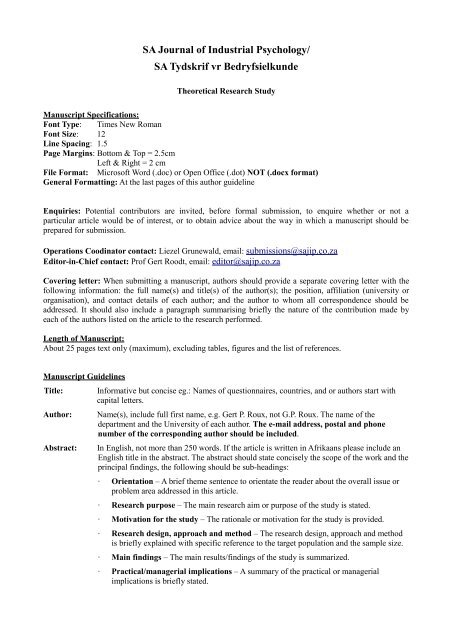
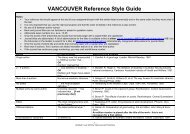
![Reference Style Guide [17-09-2008 Tdv].pdf](https://img.yumpu.com/42195443/1/184x260/reference-style-guide-17-09-2008-tdvpdf.jpg?quality=85)
